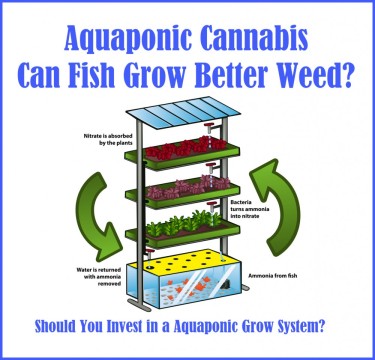
Hydroponics, composting, vermiculite… these are just some of the many common fertilizers that are used for growing cannabis.
But did you know that fish excrement is an excellent fertilizer too?
It’s a terrific source of phosphorus, nitrogen, magnesium, calcium, and potassium. These are all nutrient powerhouses for growing plants including cannabis when using an aquaponic growing system.
There are many benefits to going aquaponic compared to other types of cannabis grows, and fish waste is a key way to succeed in this arena. The fish waste is rich in ammonia, and when they are excreted in the tank or reservoir, the ammonia is distributed through the growing system. Afterwards, there are naturally occurring bacteria in the water that will convert the ammonia into nitrites, then other beneficial bacteria transform the nitrites into food for marijuana.
Marijuana metabolizes the nitrates efficiently, so that the plant can have all the nutrients that it needs to grow well while also purifying the water for the fish to live in. As a result, it produces a symbiotic relationship between the plants and the fish, in an ecosystem that is all natural and enables growers to produce high-quality organic medical marijuana without the need for harmful chemicals, fertilizers, and pesticides.
Using fish excrement is already a common practice when growing cannabis using aquaponics, but you can also use it even in non-aquaponic grows. However, the use of animal waste as fertilizer is nothing new, though it was usually extracted from land-based animals such as cows, chicken, sheep, pigs, horses, and others. The problem is that breaking down the manure from land-based animals is a lengthy process; for it to be used efficiently by plant growers - in this case cannabis, you want quality excrement that breaks down quickly so that your crops can feed on it.
Benefits of Using Fish Poop
Fish poop acts much quicker, so it can get its nutrients into the soil quickly. But there are other benefits too: it’s more efficient, more affordable, and helps you get potent, bigger grows all while being environmentally-friendly.
If you are interested in using fish poop as fertilizer, be sure to do it yourself or obtain it from a quality source. This way you can have peace of mind that the fish itself aren’t exposed to pesticides or fertilizers, or that would cancel out the benefits of using fish poop instead of chemicals in the first place.
Let’s take a look at businesses that are already using fish poop successfully – these may inspire you to try it yourself.
Thumb Genetics: Michigan
An article by MLive shares insight into how Thumb Genetics, a licensed cannabis grow operation in Michigan, already uses fish poop.
Thumb Genetics is a family-owned business that uses aquaponics to grow cannabis. “I can guarantee you’ve never been in a grow like this,” explains director Lloyd Owens, who operates the grow with his son, Jack. “This is the most insane grow you… have ever been in.”
While aquaponics is more common in growing lettuce or other vegetables, it’s not widely done in the cannabis world… just yet. But aquaponics is all about efficiency, and you no longer need pricey fertilizers or tons of nutrients for the soil. “Basically, it’s about $80 worth of fish food per month, versus tens of thousands of dollars in chemicals each month,” explains Lloyd. “The other thing is: all these other grows, they waste all this water.”
“We’ve eliminated all the media, because our media is reusable, we’ve eliminated all the fertilizer, and the fact that we don’t have to transplant and that, we’ve minimized our employees… We’ve had the same water in those tanks for about a year and a half.”
Thumb Genetics makes use of blue Nile Tilapia fish, thousands of them in different ages, that swim freely in dark water. Bigger elder fish swim in an area with safety nets above, which prevent occasional suicidal attempts at the concrete below them. This kind of fish was chosen precisely because they don’t reproduce, and so as long as they keep the temperatures regulated to below 82 degrees, they will continue pooping healthily.
“We have different life cycles right now,” explains Jack. “We can probably keep these for another six months, but they’re definitely getting to the size where they don’t poop as frequent as the smaller ones.”
Green Relief: Ontario
Green Relief Inc. has an underground facility in Ontario which is home to a state-of-the-art aquaponics farm for growing cannabis. They have been using filtered fish excrement as fertilizer for the marijuana, which then cleans the water for the fish.
Because of this, they no longer have to use pesticides. However, it took them 2 and a half years to sort out the process.
“This is the agriculture of the future,” explains co-founder Warren Bravo. “If you’re not latching on to sustainable agriculture technologies now, you’re going to be a dinosaur.”
Their farm utilizes a closed-loop system involving 6,000 tilapia fish plus 4,500 cannabis plants. Despite that, they consume 90% less water compared to conventional agriculture while still enjoying 10-20% higher yields, reports Global News Canada. Lynn, Warren’s wife and the primary architect for the company, tells Green Rush Daily that “it’s absolutely impossible to use any harmful chemicals, because the fish will suffer, and the whole system will fail.”
Have you tried using fish poop for your home grow? What was the experience like?
USING FISH TO GROW WEED, READ MORE...
DO FISH GROW BETTER WEED, LEARN ABOUT AQUAPONICS!








